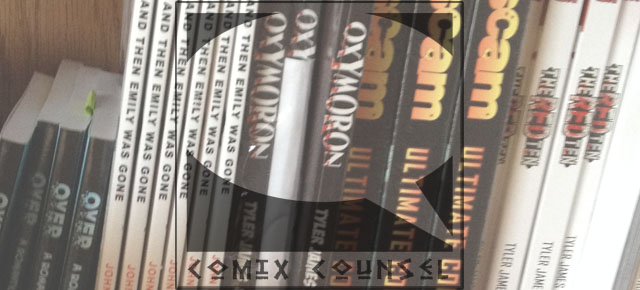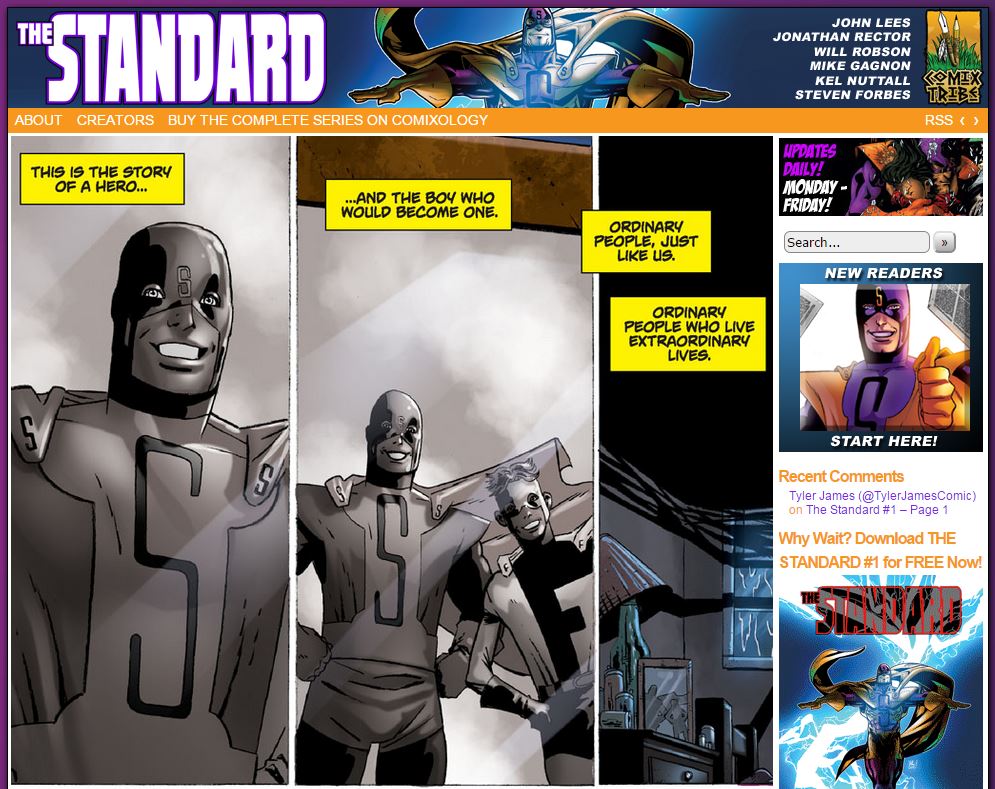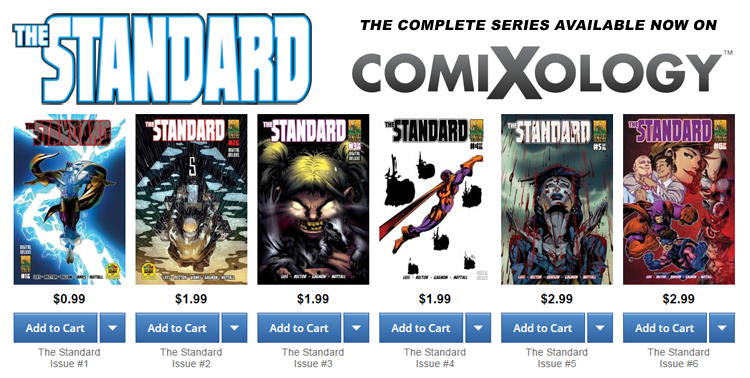5 Ways to Benefit from Your Backlist
“Wow, so all this is you?”
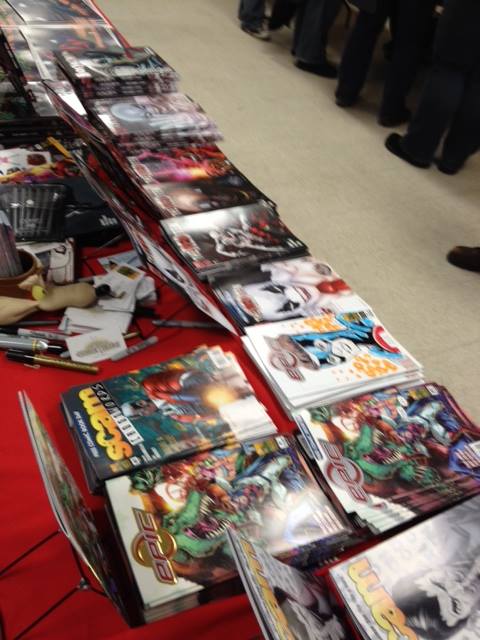 That was the line I heard most at conventions in 2014. Somehow, slowly, steadily, ComixTribe has become a big fish in the small-press and artist alley sections of most of the conventions we attend. In SCAM, THE STANDARD, and AND THEN EMILY WAS GONE, we now have three complete mini-series under our belt. By the end of this year, we’ll have half a dozen collected editions. In short, we now have a backlist.
That was the line I heard most at conventions in 2014. Somehow, slowly, steadily, ComixTribe has become a big fish in the small-press and artist alley sections of most of the conventions we attend. In SCAM, THE STANDARD, and AND THEN EMILY WAS GONE, we now have three complete mini-series under our belt. By the end of this year, we’ll have half a dozen collected editions. In short, we now have a backlist.
In comics, its easy to always look forward — the next series, the next issue, the next page, the next panel, and so on. And I do spend most of my time working on projects I haven’t even announced publicly yet. There is no laurels-resting in indie comics. However, it’s absolutely critical to be strategic about continuing to squeeze value out of your backlist. As a creator or publisher, your backlist represents a tremendous amount of time and financial resources already invested, and it’s critical to your future success to continue to get as much of a return out of that previous investment.
Look at Robert Kirkman. New issues of The Walking Dead are near the top of the comics charts every month, but it’s his backlist, those early collections and compendiums of work done years ago selling in bookstores around the world that make up the bulk of that series’ revenue. While Kirkman’s series success is an extreme outlier, every publisher puts considerable effort into maximizing the value from their backlist. So, too should independent creators and small press publishers. This article will cover five ways to do just that.
1. Give Away Backlist Titles to Build Your Mailing Lists
Ask nearly any creative entrepreneur what their most valuable asset is, and I’d venture email contact list ranks right up there. An email list gives you a direct line of communication to your fan base, and that fan base is a renewable resource. ComixTribe has supporters who have been with us from day one, and even in this Web 2.0/ social media heavy world, email is still one of the best ways we have to get a direct message to our Tribe.
One of the best ways to grow that email contact list is to offer something of value in exchange for joining the list. In last week’s AND THEN EMILY WAS GONE Postmortem, I mentioned how we were using NoiseTrade as a service to trade a FREE copy of AND THEN EMILY WAS GONE #1 for a valid email address.
And for the past few years, we’ve also been using Mailchimp, our email list manager, to offer a 100+ page ComixTribe digital comics sampler as thanks for joining our mailing list. (If you’re new to us, this is a great way to sample our titles.)
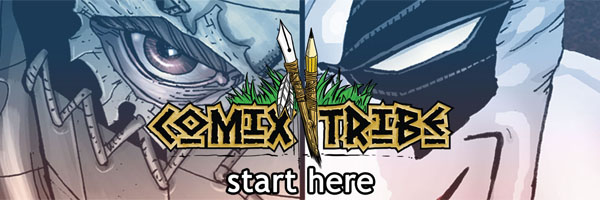
Join the ComixTribe mailing list!
As a special thanks for signing up, we’ll give you 100+ pages of FREE comics!
An objection to giving away these free issues is that it’s devaluing the issues, and that we’re losing out on potential sales. However, it’s important to recognize that these are backlist titles, many of which are out of print. In the case of AND THEN EMILY WAS GONE, that book is available on Comixology for $1.99, so yes, we could conceivably be losing out on $0.99 (our share of a book sold there) if someone downloads for free through NoiseTrade. However, there’s a high likelihood the person downloading the book for free was never going to pay for it in the first place. And I’d argue the ability to start a dialog with that new reader via a future email is well worth 99 cents. Remember, when you sell a book on Comixology, that person is Comixology’s customer, not yours.
2. Backlist Binge Reading on Comic Subscription Services
The big comic industry news that kicked off last week was that e-book subscription service Scribd is making a major push into comics and graphic novel distribution, inking deals with Marvel, IDW, TopCow, Dynamite, and more, to carry backlist titles. This business model offers Scribd subscribers unlimited reading for a low monthly cost. Scribd is already a major player in the e-book space, and is making a push to become the Netflix for comics.
If the “Netflix for comics” slug-line sounds familiar, you may be remembering the Comix Counsel article I wrote last year about Comicsfix, another comic book subscription service offering all you can read comics for one low monthly price. Comicsfix has continued to grow its library over the past year, signing top ten publishers including IDW, Valiant, Dynamite, as well as a large collection of indie and small-press titles. Comicsfix has an active presence on the convention circuit, and send out a weekly Sunday Morning Reading email with recommendations to their mailing list.

It may be worth a follow up to compare the comics reading experience on Scribd and Comicsfix, and I’ll admit, I haven’t taken a careful look into either platform yet. It will be interesting to see how Comicsfix responds to the much larger Scribd landing the “white whale” that is Marvel. It will also be interesting to see how good a reading experience the Scribd platform offers, as it wasn’t designed specifically with comics in mind as Comicsfix and Comixology’s readers were.
So, should creators and small-press publishers be scrambling to get their books on these platforms?
The Scribd news is less than a week old. Scribd is a platform that has been very open to self-publishers in the e-book space, so it’d be surprising if they weren’t also welcoming for independent comic creators. We know Comicsfix’s arms are wide-open to the indies. But I also haven’t heard of any creators receiving any payment yet from Comicsfix, and I know I haven’t seen a statement regarding the one book we have on that platform. (If you’re a creator and HAVE started receiving revenue from Comicsfix, please let us know how it’s going for you.) My guess is that, at this point, the revenue potential of these platforms is still quite low.
But it’s not nothing. And generating passive income that doesn’t require any/much additional effort on your part is precisely what you want your backlist to be doing for you.
The content best suited for these platforms are complete story arcs or series, rather than single issues, as binge reading is what you’re looking to trigger. I wouldn’t put front list titles or series still in development on these platforms. But if you have some series that are complete and near the end of their direct market life cycle, they may find new life on one of these platforms.
3. Bundle the Backlist into an Unbeatable Deal
One of the more remarkable developments of last year was the tremendous success of comic book Humble Bundles. I wrote a column last year on the Bundle phenomenon, and since then, even more comic publishers have raised hundreds of thousands of dollars bundling backlist comics and selling them together at a tremendous discount.
Is this action independent creators and small-press publishers can get in on?
The challenge is that bundles work because the offers are so unbelievable good, it’s near impossible for even the most tight-fisted comic book fan to resist them. What makes a bundle offer good is the massive treasure trove of comics being offered. The Image Humble Bundle offered four of Image’s top selling trades for as little as a penny, and you could get all twelve trades for just $15. Buying the same exact comics on Comixology or in shops would cost well over $100, an incredible deal.
This is a problem for us, because most small-press publishers or independent creators simply don’t have that large a high-profile backlist to craft an offer compelling enough to get people excited.
However…
…were a number of independents and small-press publishers to team up and form a small-press supergroup, I think a compelling bundle could be generated. Say ComixTribe, Action Lab, 215 Ink, Th3rd World Studios, Fubar Press, and a collection of handpicked self-publish rockstar creators joined forces in one Indie Comics Humble Bundle, I’m pretty sure we could craft a killer offering that would do very well.
I guess the question is, what the hell are we waiting for? : )
4. Use Your Backlist for Crowdfunding Rewards
Crowdfunding efforts, whether on Kickstarter, Indiegogo, or Patreon, are awesome opportunities to activate your backlist. The old saying goes, the best time to sell someone something is when they already have their wallets open. (“Would you like fries with that?” only replace fries with more comics.) A Kickstarter campaign is a wallet open environment, and anyone who’s run a successful campaign quickly learns that often your best way to raise funds is by getting people already pledging to your campaign to upgrade their pledge to give a little more to get a lot more. I’ve definitely used ComixTribe backlist titles to help build and maintain momentum during our Kickstarter campaigns.
For example, in the EPIC #1 Kickstarter, after hitting the $6,000 mark, we gave all backers their choice of a free ComixTribe comic from our backlist.

Jimmy Palmiotti, who now has eight successfully funded Kickstarter graphic novel projects under his belt, always includes reward tiers that offer the new project mixed with backlist work. (I particularly like his “Mystery Box” rewards.)
Erika Moen, who I talked to a while back in my article on Patreon, and who is up to $1,118 per Oh Joy Sex Toy comic update on her Patreon page, offers PDFs of her backlist comics to $5/ update Patrons as an added bonus. And Zach Weinersmith of SMBC, who is now getting more than $105K per year in pledges via Patreon, uses PDFs of his backlist comics as rewards for all patrons when hitting certain funding milestones.
It’s clear that whenever you’re running a crowdfunding campaign for a new or current project, you should think about how to use your backlist titles to further the cause.
5. Give New Life to Your Backlist Through Webcomic Serialization
And then there’s webcomics, with backlist titles being particularly well-suited for serializing on the web. Why? Because often the single biggest difficulty webcomics creators face is releasing content on a consistent schedule. The grind of producing a webcomic puts a ton of pressure on creators. With backlist books, the hard part (creating the comic) is already done. All that’s left to do is build a website and upload pages to it.
As our EIC Mr. Steven Forbes says, “Here’s the thing about webcomics: people love free. They love it in droves. They want to be entertained, they want to be entertained well, and they want to be entertained for free.”
Sometimes creators get caught up on pricing… should my book be $1.99, $2.99, $3.99? At what price will the market respond to my book? Unfortunately, for a vast segment of the comic market, they won’t buy our books for any price. They simply won’t take a chance on new creators…not when there are more books from writers and artists they already know they like out there than they could ever afford. So, how do you get these readers to ever give you a shot?
Webcomics is one answer. And, in fact, it’s something that ComixTribe is experimenting with, starting today, as we’ve just launched John Lees’ THE STANDARD as a serialized webcomic with new behind the scenes creator commentary accompanying every page. The first 8 pages of THE STANDARD is online right now, and the site will update with a new page daily Monday – Friday going forward. If you haven’t read THE STANDARD, you are in for a treat, as this series is without a doubt one of the best superhero stories released in the past decade.
Now, I know many creators have objections about putting their work online for free in the webcomic format. In fact, John Lees himself had plenty of reservations. When we first discussed webcomic serialization of THE STANDARD, John worried it’d be like “putting a square peg in a round hole” meaning a story written for an issue format may not translate as well on the web. And I don’t think John is wrong about that. But just because it’s not the absolute best way to enjoy his story, doesn’t mean that it’s not an avenue worth exploring… especially when it has the potential to reach literally hundreds of thousands of new readers.
I also think that history has proven very little to no downside of serializing backlist books online for creators. While these are but a few examples, I’m highly doubtful that Jim Zub, Charles Soule, or Kurtis Wiebe have any regrets about serializing Skullkickers, 27, or Green Wake as webcomics, given how their careers are doing at the moment.
If you are going to serialize a backlist title, however, I think it is important to be clear about what your goals are in doing so. This way, you can determine at a later date whether it was a successful strategy. As a publisher, the goals of serializing THE STANDARD online are as follows:
- To increase awareness for THE STANDARD, which was criminally under-ordered in the direct market, and rekindle buzz for the series, especially as John Lees now has more “heat” thanks to the incredible reception of his second series AND THEN EMILY WAS GONE.
- Create an interested reader contact acquisition funnel, and use it to build our ComixTribe reader email list. (This is strategy #1 at the top of this article.)
- Use the website as a potential launching point for a future crowdfunding campaign for a hardcover collection of THE STANDARD, with daily updates acting as marketing throughout the Kickstarter campaign.
- Get John Lees more readers and THE STANDARD more fans, and use this backlist asset as a platform builder for all his future projects.
- Drive digital sales on Comixology for readers who get hooked and simply can’t wait for the daily updates to read more.
So, What Did I Miss?
Keep Reading!
If you found this article useful, you may want to read one of these three articles next:
Bundle is the New Black
A $95,000 Tip Jar for Comics? 10 Thoughts on Patreon
A Netflix for Comics? A ComicsFix Interview
Related Posts:
Category: Comix Counsel

